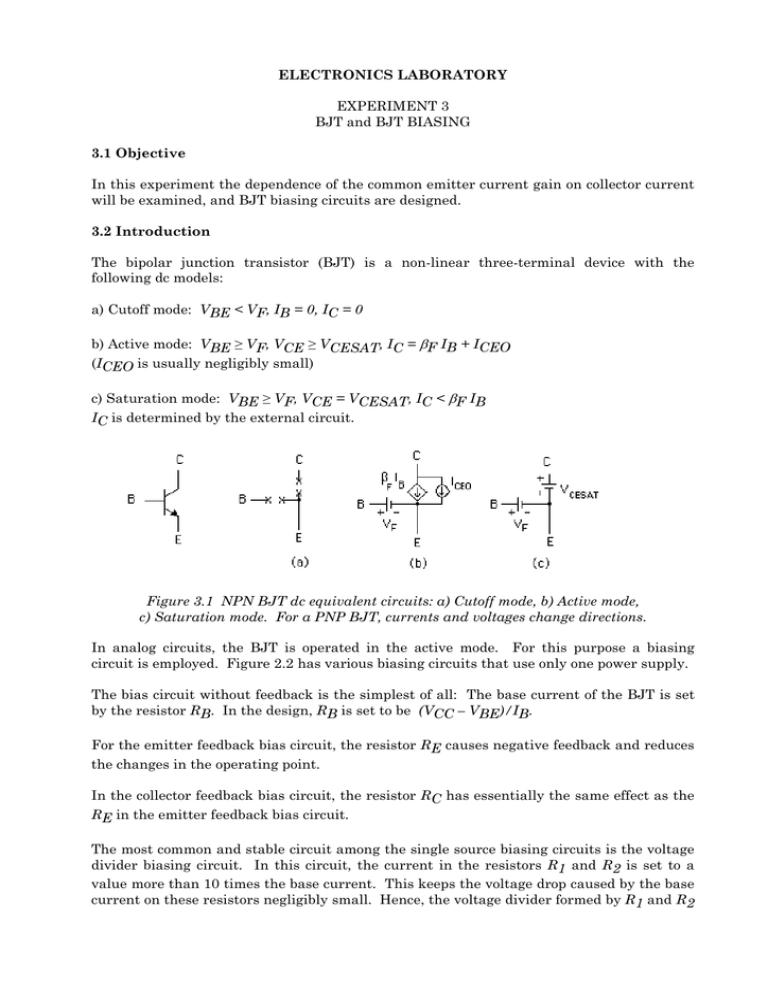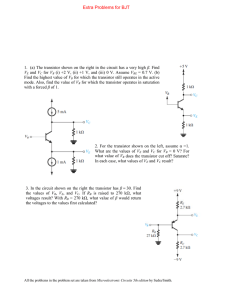BJT and BJT Biasing
advertisement

ELECTRONICS LABORATORY EXPERIMENT 3 BJT and BJT BIASING 3.1 Objective In this experiment the dependence of the common emitter current gain on collector current will be examined, and BJT biasing circuits are designed. 3.2 Introduction The bipolar junction transistor (BJT) is a non-linear three-terminal device with the following dc models: a) Cutoff mode: VBE < VF, IB = 0, IC = 0 b) Active mode: VBE ≥ VF, VCE ≥ VCESAT, IC = βF IB + ICEO (ICEO is usually negligibly small) c) Saturation mode: VBE ≥ VF, VCE = VCESAT, IC < βF IB IC is determined by the external circuit. Figure 3.1 NPN BJT dc equivalent circuits: a) Cutoff mode, b) Active mode, c) Saturation mode. For a PNP BJT, currents and voltages change directions. In analog circuits, the BJT is operated in the active mode. For this purpose a biasing circuit is employed. Figure 2.2 has various biasing circuits that use only one power supply. The bias circuit without feedback is the simplest of all: The base current of the BJT is set by the resistor RB. In the design, RB is set to be (VCC – VBE)/IB. For the emitter feedback bias circuit, the resistor RE causes negative feedback and reduces the changes in the operating point. In the collector feedback bias circuit, the resistor RC has essentially the same effect as the RE in the emitter feedback bias circuit. The most common and stable circuit among the single source biasing circuits is the voltage divider biasing circuit. In this circuit, the current in the resistors R1 and R2 is set to a value more than 10 times the base current. This keeps the voltage drop caused by the base current on these resistors negligibly small. Hence, the voltage divider formed by R1 and R2 is considered as an independent voltage source to set the voltage at the base of the BJT. The resistor RE provides negative feedback and sets the emitter current. Figure 3.2 BJT biasing circuits: a) Without Feedback, b) Emitter Feedback, c) Collector Feedback, d) Voltage Divider The operating point of a transistor in a circuit depends not only on the voltage sources and resistors, but also on VF, βF and ICEO of the transistor. These parameter differ from device to device; they are also temperature dependent. To keep the operating point of the transistor fixed, a stable biasing circuit is preferred. The stability of a biasing circuit may be defined in various ways. One of these ways is the sensitivity: S= ∂I C ∂I CO (3.1) S´ = ∂I C ∂V BE (3.2) ∂I C ∂β F (3.3) S´´ = Using these definitions, the change in the collector current may be found: ∆IC = S´´∆βF + S ∆ICO + S´∆VBE (3.4) The sensitivities are derived from the Ebers-Moll equations, specifically the following expression: (3.5) IC = βFIB + (βF + 1) ICO 3.3 Preliminary Work 1) Obtain 2 NPN Bipolar junction transistors — one general purpose, one low–power power transistor. You may use manufacturers’ data books or other catalogs to make your selection. 2) For the general purpose transistor, design 4 bias circuits that are given above so that IC = 1 mA and VCE = 3 V. 3) Calculate S´´ sensitivities for all of your design circuits. 4) Using the .OP command in PSPICE or using other simulation programs such as Workbench, determine the operating point for each circuit. 5) Replace the general purpose transistor with the power transistor and determine the operating point in each circuit. 3.4 Experimental Work 1) Using the circuit given in Figure 2.3, determine for each transistor how the common emitter current gain of the transistor changes with the collector current. You may take 8 to 10 readings for each transistor. You may change the resistors in the circuit if it becomes necessary. Make sure that each transistor operates in the active mode. 12-15 V RC R1 10kΩ mA R2 1kΩ RB 1kΩ μA Figure 2.3 A circuit to measure the common emitter current gain of an NPN bipolar transistor. 2) Build the circuits that you have designed in the preliminary work section. Determine the operating point of the general purpose transistor experimentally and compare it with the theoretical operating point. 3) Replace the transistor with the power transistor and determine the operating point for each bias circuit. 4) Compare the stabilities of four bias circuits.




